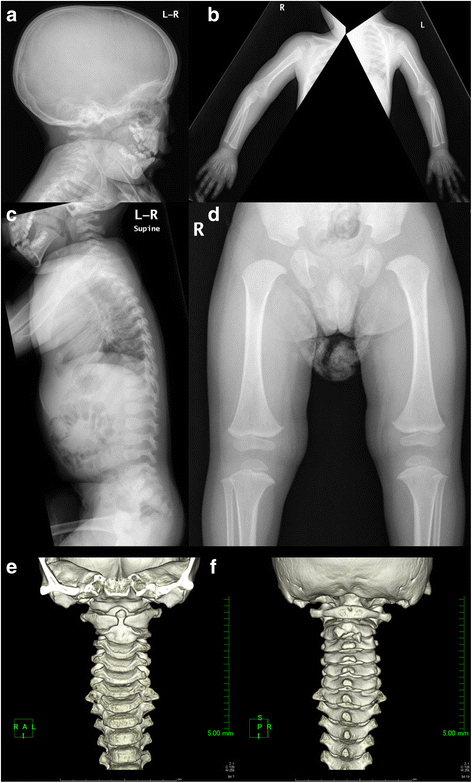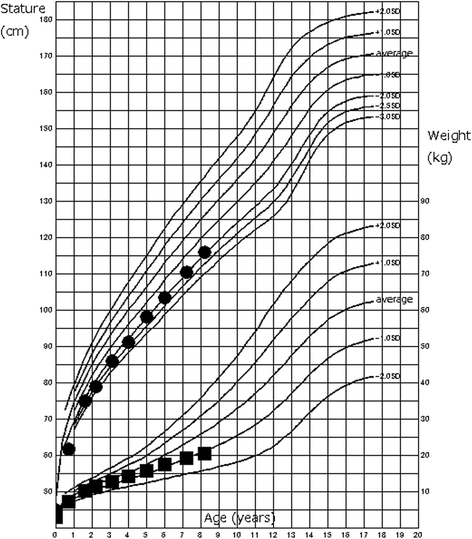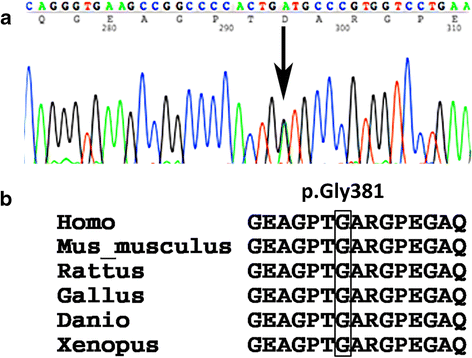A novel mutation in the COL2A1 gene in a patient with Stickler syndrome type 1: a case report and review of the literature
- PMID: 28841907
- PMCID: PMC5574094
- DOI: 10.1186/s13256-017-1396-y
A novel mutation in the COL2A1 gene in a patient with Stickler syndrome type 1: a case report and review of the literature
Abstract
Background: Stickler syndrome is a group of collagenopathies characterized by ophthalmic, skeletal, and orofacial abnormalities, with the degree of symptoms varying among patients. Mutations in the COL2A1, COL11A1, and COL11A2 procollagen genes cause Stickler syndrome. Marshall syndrome, caused by a COL11A1 mutation, has clinical overlap with Stickler syndrome.
Case presentation: A 2-year-old Japanese boy was presented to our hospital with short stature (79.1 cm, -2.52 standard deviation). His past medical history was significant for soft cleft palate and bilateral cataracts. He had a flat midface, micrognathia, and limitations in bilateral elbow flexion. Radiographs showed mild spondyloepiphyseal dysplasia. Initially, we suspected Marshall syndrome, but no mutation was identified in COL11A1. At 8 years old, his height was 116.2 cm (-1.89 standard deviation), and his orofacial characteristics appeared unremarkable. We analyzed the COL2A1 gene and found a novel heterozygous mutation (c.1142 G > A, p.Gly381Asp).
Conclusions: In this case report, we identify a novel missense mutation in the COL2A1 gene in a patient with Stickler syndrome type 1, and we describe age-related changes in the clinical phenotype with regard to orofacial characteristics and height. Genetic analysis is helpful for the diagnosis of this clinically variable and genetically heterogeneous disorder.
Keywords: COL2A1; Marshall syndrome; Stickler syndrome; Type II collagenopathy.
Conflict of interest statement
Ethics approval and consent to participate
This study was approved by the institutional review board of Okayama University Hospital for clinical research. All procedures performed in studies involving human participants were done in accordance with the 1964 Helsinki declaration and its later amendments.
Consent for publication
Written informed consent was obtained from the patient’s legal guardian(s) for publication of this case report and any accompanying images. A copy of the written consent is available for review by the Editor-in-Chief of this journal.
Competing interests
The authors declare that they have no competing interests.
Publisher’s Note
Springer Nature remains neutral with regard to jurisdictional claims in published maps and institutional affiliations.
Figures



Similar articles
-
Case report of the first molecular diagnosis of Stickler syndrome with a pathogenic COL2A1 variant in a Mongolia family.Mol Genet Genomic Med. 2021 Oct;9(10):e1781. doi: 10.1002/mgg3.1781. Epub 2021 Aug 18. Mol Genet Genomic Med. 2021. PMID: 34405586 Free PMC article.
-
Distinguishing Marshall from Stickler syndrome: a clinical and genetic challenge.Clin Dysmorphol. 2021 Jan;30(1):58-61. doi: 10.1097/MCD.0000000000000346. Clin Dysmorphol. 2021. PMID: 32897902 No abstract available.
-
Genetic testing results of children suspected to have Stickler syndrome type collagenopathy after ocular examination.Mol Genet Genomic Med. 2021 May;9(5):e1628. doi: 10.1002/mgg3.1628. Epub 2021 May 5. Mol Genet Genomic Med. 2021. PMID: 33951325 Free PMC article.
-
Stickler syndrome, ocular-only variants and a key diagnostic role for the ophthalmologist.Eye (Lond). 2011 Nov;25(11):1389-400. doi: 10.1038/eye.2011.201. Epub 2011 Sep 16. Eye (Lond). 2011. PMID: 21921955 Free PMC article. Review.
-
Hearing Loss in Stickler Syndrome: An Update.Genes (Basel). 2022 Sep 1;13(9):1571. doi: 10.3390/genes13091571. Genes (Basel). 2022. PMID: 36140739 Free PMC article. Review.
Cited by
-
Unsuccessful tracheal intubation in a patient with Kniest dysplasia undergoing repeated general anesthesia: a case report.JA Clin Rep. 2018 May 18;4(1):41. doi: 10.1186/s40981-018-0178-x. JA Clin Rep. 2018. PMID: 32025981 Free PMC article.
-
Med23 Regulates Sox9 Expression during Craniofacial Development.J Dent Res. 2021 Apr;100(4):406-414. doi: 10.1177/0022034520969109. Epub 2020 Nov 6. J Dent Res. 2021. PMID: 33155500 Free PMC article.
-
A large multiethnic GWAS meta-analysis of cataract identifies new risk loci and sex-specific effects.Nat Commun. 2021 Jun 14;12(1):3595. doi: 10.1038/s41467-021-23873-8. Nat Commun. 2021. PMID: 34127677 Free PMC article.
-
Spontaneous lens resorption in a patient with Marshall-Stickler Syndrome and glaucoma.Am J Ophthalmol Case Rep. 2022 Feb 9;25:101406. doi: 10.1016/j.ajoc.2022.101406. eCollection 2022 Mar. Am J Ophthalmol Case Rep. 2022. PMID: 35198824 Free PMC article.
-
Extracellular Matrix Remodeling During Palate Development.Organogenesis. 2020 Apr 2;16(2):43-60. doi: 10.1080/15476278.2020.1735239. Epub 2020 Mar 31. Organogenesis. 2020. PMID: 32233728 Free PMC article. Review.
References
Publication types
MeSH terms
Substances
Supplementary concepts
LinkOut - more resources
Full Text Sources
Other Literature Sources
Medical
Miscellaneous

